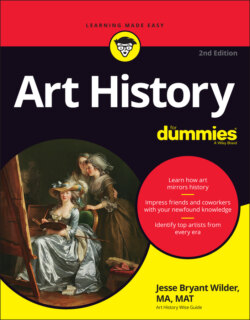Читать книгу Art History For Dummies - Jesse Bryant Wilder - Страница 126
The Archaic period
ОглавлениеEventually, the Greeks put their own stamp on all cultural imports. But in the seventh and sixth centuries BC, during the Archaic period (650 BC–480 BC), Greek sculptures look like hand-me-down Egyptian tomb statues. The artists obviously spent time in Egypt or studied the imports closely.
Compare the Archaic Greek statue of a kouros (see Figure 7-2) from the Metropolitan Museum of Art (c. 590–580 BC) with the Egyptian statues of King Menkaura and his queen in the Museum of Fine Arts, Boston at mfa.org (sculpted in roughly 2515 BC). Almost everything about the Archaic Greek statue says, “I’m Egyptian.” The kouros is as symmetrical and rigid as the pharaoh’s statue, though the Menkaura sculpture is more refined. Both the kouros and King Menkaura have these similarities:
Squared shoulders; straight, rigid arms and legs; and clenched fists held firmly at their sides
The left foot stepping slightly forward
Pronounced, geometric kneecaps, and the same angular calves, as if they’d been shaped with an old-fashioned wood shaver
Fletcher Fund, 1932 / The Metropolitan Museum of Art
FIGURE 7-2: Marble Kouros statue from Attica (Athens and surrounding area).
But there are differences. The kouros is completely naked. Pharaohs were never represented nude; in fact, only Egyptian children were routinely shown in the buff.
The female version of the Archaic statue is called a kore, which means “maiden.” Kores are never nude. Only Greek men were allowed to prance around town in the altogether. Greek women usually stayed indoors to do the sewing and cooking (except in Sparta). When they went out to collect water, for example, they wore long gowns.
The Greeks gradually shed strict Egyptian symmetry for a more subtle form of balance. The kouros in Figure 7-3, sculpted circa 525 BC, about 60 years after the kouros at the Metropolitan Museum of Art, is much more realistic, though he’s still stuck in the same Egyptian pose. Notice how much more lifelike the finely modeled curves of the shoulders, arms, and thighs are than in the earlier version. The older statue looks like a stone man. The later one is nearly a flesh-and-blood athlete; he’s almost ready to learn to walk.
Lefteris Papaulakis / Shutterstock
FIGURE 7-3: Although still at attention like a frozen soldier, this later kouros, called Kroisos, shows the Greek progression toward naturalistic sculpture (making stone look like real flesh).
But giving statues the semblance of motion took another hundred years. First, sculptors had to learn to depict the body in a relaxed rather than rigid posture.
